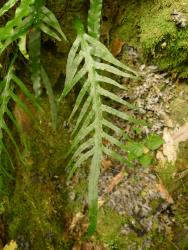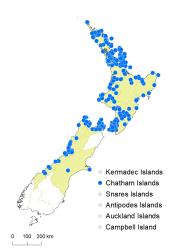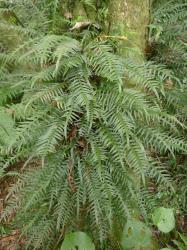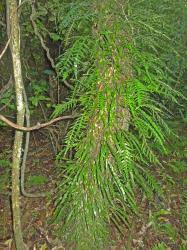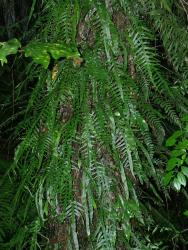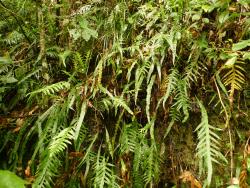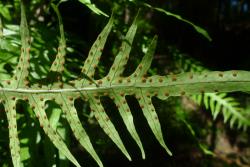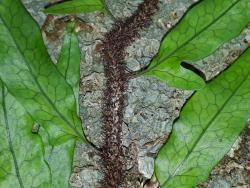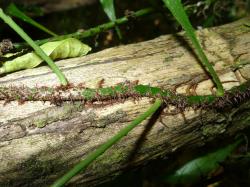- ≡ Polypodium scandens G.Forst., Fl. Ins. Austr. 81 (1786)
- ≡ Phymatodes scandens (G.Forst.) C.Presl, Tent. Pterid. 196 (1836) nom. illeg.
- ≡ Drynaria scandens (G.Forst.) Fée, Mém. Foug., 5. Gen. Filic. 271 (1852)
- ≡ Microsorum scandens (G.Forst.) Tindale, Amer. Fern J. 50: 241 (1960) – as Microsorium
- ≡ Phymatosorus scandens (G.Forst.) Pic.Serm., Webbia 28: 459 (1973)
- ≡ Dendroconche scandens (G.Forst.) Testo, Sundue, & A.R.Field, Syst. Bot. 44: 748 (2019)
Epiphytic and terrestrial; creeping or climbing fern. Rhizomes long-creeping, 2–4 mm diameter, wiry, scaly. Rhizome scales clathrate, narrowly triangular in the upper part but abruptly widened to a broadly ovate base, 3–6 mm long, 0.5–2 mm wide (at base), squarrose, blackish-brown, entire. Roots of two types, one laterally inserted and clasping, the other ventrally inserted and attached to soil. Fronds 45–620 mm long. Stipes 5–120 mm long, pale brown, glabrous or with scattered scales. Laminae very varied, from undivided or variously lobed to deeply 1-pinnatifid; undivided laminae narrowly ovate to narrowly elliptic or linear, 40–430 mm long, 3–25 mm wide; lobed or pinnatifid laminae narrowly ovate to narrowly elliptic or occasionally ovate to elliptic, 110–540 mm long, 25–190 mm wide; lamina alate for 10–160 mm below the lowest lobe, dull dark green, herbaceous, glabrous or with scattered scales along the costae. Lamina lobes in 1–20 pairs, 15–105 mm long, 3–11 mm wide, straight or slightly falcate, acuminate, margins entire or wavy, widest at base. Veins reticulate, forming 1–2 series of areoles between costa and lobe margin; hydathodes present but inconspicuous on adaxial surface of lamina. Sori round or slightly elongate, 1–3 mm long, superficial or impressed into lamina forming low bulges on adaxial surface, in 1 row close to lobe margin on either side of the costa; paraphyses absent; exindusiate.
This species can be distinguished from the other species of Lecanopteris in New Zealand by its thin (<4 mm diameter) wiry rhizome with small, squarrose, blackish-brown scales, thinner dull green laminae, and generally smaller sori. It also has a musky scent when fresh, as reflected in its common name.
Occasional aberrant forms are found – either crested at the apices or with bifid laminae.
North Island: Northland, Auckland, Volcanic Plateau, Gisborne, Taranaki, Southern North Island.
South Island: Western Nelson, Sounds-Nelson, Westland, Canterbury.
Chatham Islands.
Altitudinal range: 0–800 m
Common from near sea level in coastal and lowland areas of the North Island, extending locally to 800 m in montane forest, but largely absent from high country areas in Taranaki, Volcanic Plateau and Gisborne. In the South Island, largely confined to coastal areas of the Marlborough Sounds, Nelson and Westland, extending locally to 500 m and as far south as Haast. Absent from most of the east coast except for outlying populations on Banks Peninsula and in Peel Forest.
Also Australia (Queensland, NSW, Victoria), Lord Howe Island.
Creeping on the ground, over rocks or on banks, climbing trees, or epiphytic. Common in a wide range of coastal and lowland scrub and forest, usually in damper habitats.
n = 37 (Brownlie 1958, as Microsorium pustulatum).
This fern has been widely misidentified by earlier New Zealand authors as Polypodium pustulatum, Phymatodes pustulata or Microsorium pustulatum (see Brownsey et al. 1985).



